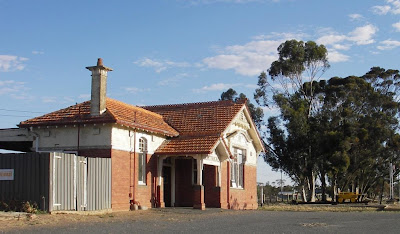Mildura/Yelta (Ballarat to Ouyen) Line The line was opened between Ballarat and Maryborough by 1875, and extended to St Arnaud in December 1878, Donald in February 1882, and Ouyen by 1903.
 |
| Emu station in 1971 (from "VR stations & stopping places") |
 |
| Emu today |
The railway reached St Arnaud in December 1878, while the station was built in 1879, the building was reflecting the gold mining heritage. Made of brick with cast iron verandah supports, the station master’s residence was incorporated into the design. No passenger trains have called here since 1993, the yard still sees use for freight. It is on the register of heritage buildings, as well as the unusual hemispherical water tower, the last of this design remaining.
.JPG) |
| The St Arnaud turntable with the water tank behind & station building behind that |
 |
| Trees stand behind the Sutherland platform mound |
 |
| Swanwater silos |
Talking with an ex-railwayman, he believes there was also a siding named Laen, south of Donald.
The line reached Donald in February1882, during the summer drought of 1881-82, so the railway was needed to cart water to the town (nearly 2 million gallons of water were delivered to the town before the drought broke). The line opened for passengers and mail in April 1882.
.JPG) |
| Chute of the Cope Cope silo looking across the platform mound to a railway house |
.JPG) |
| Freezer works on the left of the line, and the slaughterhouse on the right |
.JPG) |
| Donald station building, with the silos looming behind |
 |
| The V.R. institute & bowling green |
Buloke is only mentioned on some maps. The siding was on a crossing of the Sunraysia Highway near the southern shore of Lake Buloke.
Litchfield was a wooden portable building and platform at the wheat siding. By January 1990 the platform had been removed, now only the silos and a small goods platform remain.
 |
| The decaying platform at Litchfield |
 |
| From the level-crossing at Massey |
Watchem was opened in 1893 (it was goods only in 1892), when the line reached Birchip. A grain shed was erected in 1894, the concrete silos were built in 1939, with the steel bins added later. The Oat Growers Shed was erected in 1959. Bunkers were created in 1982. The stockyards were demolished in the late 1960s. The long demountable station building had an extra roof attached to the present roof, to form greater protection, and a verandah for passengers, prior to 1912. Passenger services ended in May 1990. The building was removed to High Street during 1991 to become a residence, only the long wide platform now remains.
Morton Plains was established in 1893 when the line was extending from Donald to Birchip. Passenger traffic peaked in 1923/4 then declined to the point it ceased in October 1966. Stock yards were erected in 1900. The silo opened in 1941.
.JPG) |
| Morton Plains, looking remarkably like a reverse of the Massey photo |
 |
| A Bulldog goods train at Birchip in the late 1910s (V.R.S. photo) |
 |
| Birchip station, the same design as at Donald |
The line reached Kinnabulla (station no. 205) in 1899 and passengers, stock and grain used the station until 1973 when the buildings, platform and facilities were removed or demolished, and Kinnabulla remained solely for grain transportation. Talking with the daughter of one of the Kinnabulla gangers last week, she reminisced about her time when there were 3 ganger family houses and a stationmaster.
.JPG) |
| Sheepyards at Kinnabulla with the fences made from railway sleepers |
 |
| Curyo weighbridge & silos |
Woomelang remained a terminus from 1899 until 1903, when the line was finally put right through to Mildura. A large standard wooden building was erected with several large tanks, a pumping plant, turnable and engine sheds. The station closed in 1993, when passenger services were discontinued on the Mildura line. The boarded-over station building, two passenger platforms and a goods shed (loosing its roof) remain.
.JPG) |
| Entrance to the Woomelang Station |
Gama
Torpey's Siding There were 3 Torpey families amongst the original settlers to the area in 1901.
 |
| The railway crossing at Torpey's Rd |
.JPG) |
| Turriff |
 |
| Steps to nowhere - the remains of the platform at Speed |
At Tempy the rail-line is bordered by the silos on one side and a roadside park on the other, roughly where the station yard once was. In the park are a number of human-powered, non-mechanical playground toys (like the rocking horse opposite). They were originally at Monash in South Australia which had a large range of non-mechanical playground/fun-park equipment: spring-loaded see-saws, flying foxes, giant slides...Public liability forced the park to tame down the collection and remove the more 'dangerous' toys.
Further information and photographs at

.JPG)
.JPG)













.jpg)
.JPG)
.jpg)
.JPG)
.JPG)
.JPG)

.jpg)
.JPG)
.JPG)

.JPG)
.JPG)

.jpg)
+-+Copy.jpg)
.JPG)

.JPG)
.JPG)

.JPG)

.JPG)
